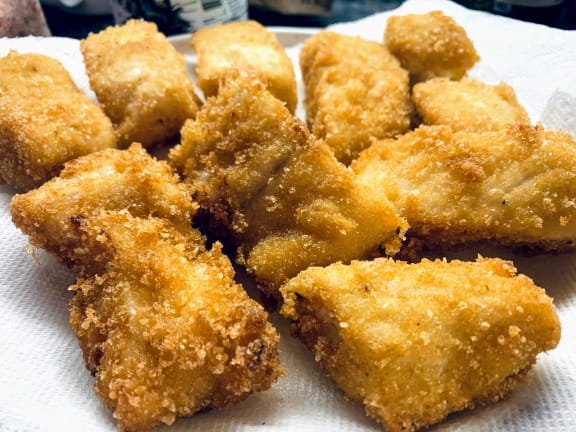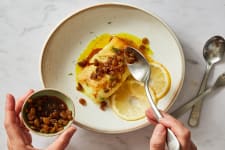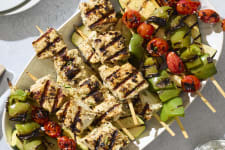Maybe you’re on a diet. Maybe you don’t like the mess of deep-frying. Or maybe you just don’t have enough oil to properly fry your wild-caught fish for the crispy recipe you had in mind. Regardless of why you’ve decided not to fry your fish for your next meal, we have one suggestion for you: Bake it ‘til you fake it.
You don’t need a pot full of hot grease for your seafood to develop a golden, crispy exterior. Instead, you can use the oven to bake fish to make it seem fried.
To faux-fry your wild-caught seafood, you will need to create a breading or crust on your fish that will pick up craveworthy texture in a hot oven.
Breading Basics
In most cases, you’ll want to dredge and bread your seafood before putting into the oven. Knowing how to dredge and bread fish is an integral kitchen skill that will help you when you want to pan-fry or faux-fry your fillets. Doing this the right way ensures that you have a flavorful crust on your fish, and that this crust sticks to the fillet when you stick a fork into it.
The first thing you’ll want to do is set up your breading station. In one plate, add enough flour to coat your fish. You can use any type of finely-ground flour here -- white, wheat, coconut, plantain. As long as it’s light enough to stick to your fillets in a fine coating, it will work. You can add in any other finely-ground elements into the flour, like a pinch of cayenne or paprika, curry powder, or old bay to give your fish a solid flavor base.
In another plate, add an egg (or more if you’re making a big batch of food). You’ll whisk this egg with a little milk or water, simply enough to thin it out.
In the last plate, add your breading of choice, whether that’s actually breadcrumbs or another alternative. This is where you also may want to add in coarser additions to the mix like grated parmesan, lemon zest, or sesame seeds.
After your breading station is set up, get your fish ready. First, pat your fillet dry with an absorbent kitchen towel or disposable paper towel. Then, season with salt and pepper before coating it in flour -- both sides, shaking off any excess -- then dip into the egg mixture, and finally the breading. Things are slightly less messy if you do one stage at a time for all of your fillets -- meaning, flour all the fillets first before moving them all to the egg mixture, and then to the breading.
From here, your fish is ready to move to the oven on a baking sheet where your breading will become a golden, crispy crust. Generally, you want your oven to be at least 400 degrees. If it’s any cooler, your breading can’t fulfill its full crunch potential.
A Few Recipes to Get Your Crisp On
Once you’re comfortable with the breading process, with cook times, and even what types of crusts you prefer to enjoy on your wild-caught seafood, you won’t need a recipe to make crispy, faux-fried fish that are perfect every time. Try out some of the following recipes to get the hang of this.
Eating Well uses a basic breading technique for its oven-fried fish and chips, made with a cornflake crust. Rather than placing the fish directly onto a baking sheet though, you’ll bake your fish on a wire rack set over a baking sheet. This will give you that all-around crisp you’d get from frying, since the wire rack allows the heat of the oven to circulate beneath your fish. Without a wire rack, the underside of your fish will still get cooked but won’t be quite as crispy.
Martha Stewart’s recipe for crisp baked cod uses cereal as well, opting for rice chex that’s been tossed with lemon zest and oil and parsley. The recipe actually skips the breading process altogether, simply asking you to press the mixture onto the fish. It’ll crumble off the fillet when you’re enjoying it, but it will still give you that crispy appeal.
Gimme Some Oven skips the flour stage and jumps straight to the egg mixture before coating nuggets of cod in toasted panko breadcrumbs for crispy fish tacos. This will still work to bread your fish, as the flour isn’t absolutely essential to the process; flour, though, helps the egg mixture to adhere to the fish better so that it doesn’t slip right off the surface. Use our pollock Quick Cuts if you want to save yourself the trouble of cutting your cod into bite-sized chunks.
For another crispy fish taco option, try this recipe from Josie and Nina which uses cornstarch, buttermilk, and cornmeal rather than the basic combination of breading ingredients to give you that fried appeal to baked fish. Any white fish will do, but rockfish will give you the most surface area to work with, which gives you the most crisp per bite.
For Air Fryer Owners
Kitchen appliance aficionados have known this for a while, but using an air fryer to cook your meals is the closest you’ll get your food to tasting fried without actually having to fry it. As with baking your fish in a conventional oven, you’ll be relying on breading and following the same process as above to create crispy texture.
Where air fryers are different than ovens are in their ability to heat your meal evenly. The air fryer, in essence, bakes your food by blasting it with heat from all sides of the appliance, giving your fish a 360 degree crisp that mimics a deep fry in a fraction of the oil. If that’s a culinary hack that appeals to your predilection for fried foods, you may seriously want to consider getting an air fryer to cook your meals. Check out our blog post on air fryer recipes and inspiration for faux-fried and beyond-fried ideas for your wild-caught seafood.






